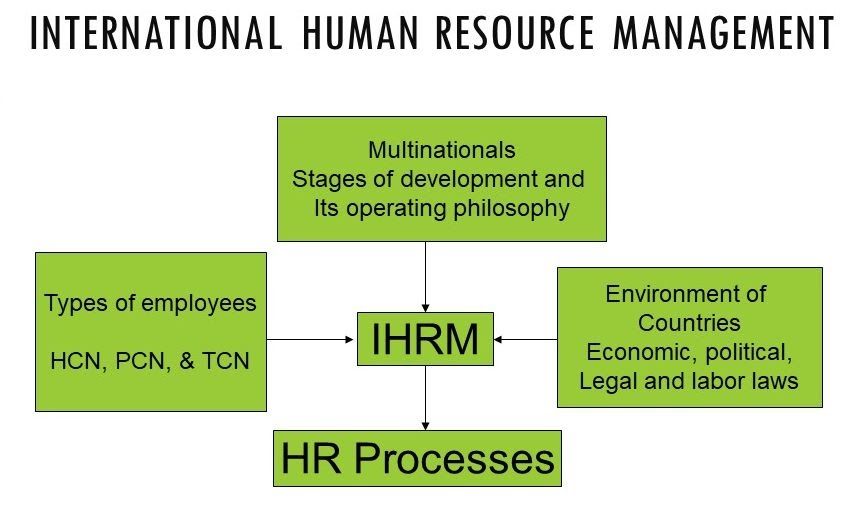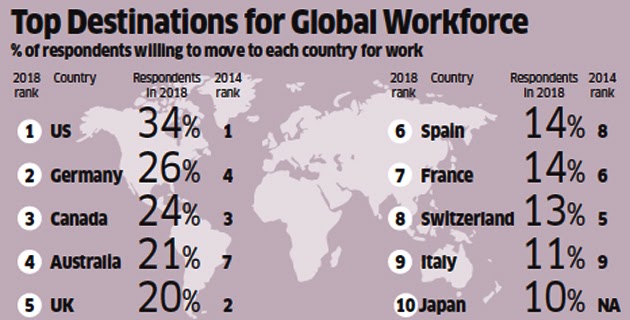
International Human Resource Management is the procurement, allocation, utilization, and motivation of human resources in international business. IHRM is defined as interaction between the three group of factors-Type of employees, environment of countries, and basic HR processes.
The national or country categories involved
- The host country where subsidiary country may be located
- The home country where the firm is headquartered
- Other countries that may be the source of labor, finance and other inputs.
The three categories of employees
- Host country nationals (HCNs)
- Parent country nationals (PCNs)
- Third country nationals (TCNs)
Global Human Resource Management
The internationalization of business has proceeded at a rapid pace as the world has become a global economy. Many U.S. firms receive a substantial portion of their profits and sales from outside the United States, and estimates are that the largest 100 U.S. multinational firms have foreign sales of more than $500 billion in one year. For firms such as Colgate and Coca-Cola, foreign sales and profits account for over 60% of total sales and profits. Other U.S. firms have substantial operations in other countries as well. Globalization has had a major impact on HR management, and has raised a number of issues.
- How should a company staff plants around the world with a mix of parent country nationals, host-country nationals, or third-country nationals?
- How will these employees be recruited, selected, trained, compensated, and managed?
- What characteristics of the countries being considered affect the HR decisions that must be made?
Year 2012: World Bank report at New York
Due to internationalization of business some countries have experienced very large increases in their labour force — nearly 8 million new entrants a year in China since the mid-1990s and 7 million in India — while others face a shrinking population. the report said. Moreover, jobs agendas at the country level are connected by the migration of people and the migration of jobs. Policies for jobs in one country can thus have spillovers on other countries – both positive and negative. At the turn of the 21st century, there were more than 200 million international migrants worldwide, nearly 90 million of them workers, the report said. source: economic times.com
Facts [+]
Two emerging human resources specialties include international human resources managers, who handle human resources issues related to a company’s foreign operations; and human resources information system specialists, who develop and apply computer programs to process human resources information, match job seekers with job openings, and handle other human resources matters.

Employees top 10 global preferences
- Good relationship with colleagues
- Good work-life balance
- Good relationship with superiors
- Learning & training opportunities
- Career development
- Financial stability of employer
- Job security
- Financial compensation
- Work being appreciated
- Interesting work
A Survey of Business Issues Worldwide
The impact of global competition can be seen in many U.S. industries. The automobile, steel, and electronics industries have closed unproductive facilities or reduced employment because of competition from firms in Japan, Taiwan, Korea, Germany, and other countries. At the same time, as the opening discussion of Mercedes in Alabama illustrates, foreign-owned firms have been investing in plants and creating jobs in the United States. The growth in employment resulting from foreign investments has helped to replace some of the jobs lost at U.S. firms due to downsizing.
An international agreement, the General Agreement on Tariffs and Trade (GATT), was signed to provide general guidelines on trade practices among nations, but a number of provisions in GATT affect HR practices in the various countries, including the United States. The brief look at the various areas of the world that follows illustrates some of those HR issues, as well as the changing nature of international economic linkages. North America The United States, Canada, and Mexico have recognized the importance of world trade by eliminating barriers and working more closely together, starting in North America. One aspect of this cooperation is that U.S. firms, as well as companies from other nations such as Japan, South Korea, and Taiwan, have taken advantage of the lower Mexican wage rates to establish operations in Mexico. The signing
of the North American Free Trade Agreement (NAFTA) expanded trade opportunities among Canada, the United States, and Mexico. But NAFTA also placed restrictions on employers to ensure that their HR practices in Mexico met certain standards. The Commission on Labor Cooperation (CLC) was established as part of NAFTA to review complaints filed in the United States, Canada, or Mexico regarding occupational safety and health, child labor, benefits, and labour management relations.
Facts [+]
5 % of U.S. adults, or about 11 million people, lack literacy in English, according to the Department of Education. People classified as Non-literate in English were not able to communicate with interviewers or were unable to answer a minimum number of questions during a literacy assessment.
Italy, France, and Germany top the list of average number of vacation days per year, according to the World Tourism Organization. Italians receive an average of forty-two vacation days per year. Korea, Japan, and the U.S. are at the bottom of the list. Americans receive an average of thirteen vacation days per year.
H-1B workers may be employed temporarily in a specialty occupation or as a fashion model of distinguished ability. A specialty occupation requires theoretical and practical application of a body of specialized knowledge along with at least a bachelor’s degree or its equivalent. An H-1B alien may work for any petitioning U.S. employer for a maximum period of six years.
Latin America
One highlight of recent years in Latin America is the resurgence of the economies of the largest countries, specifically Brazil, Argentina, and Chile. Economic austerity programs in those countries have reduced their inflation rates to more normal levels. Expanding populations created by relatively high birthrates have led to those countries being seen as attractive for foreign investment, and many multinational organizations based in the United States, Asian countries, and European nations have expanded operations through joint ventures with host country firms.
Asia
In Asia, Japan’s economy has been maturing, and Japanese society has been changing because of a rapidly aging population. Also, younger Japanese are becoming more “westernized” and are buying more imported goods. Gradually the Japanese government has had to open up its markets and make changes in its economy in response to pressure from the United States and other countries.
Economic relations between foreign firms and firms in such Asian countries as Taiwan, South Korea, Singapore, and Malaysia have become more complex, and their exports have increased dramatically. The rapid growth of the economies in those Asian countries, as well as in Indonesia, Thailand, and Vietnam, has led more foreign firms to establish manufacturing facilities there and to increase trade opportunities.
Two other Asian countries, India and China, have huge populations. Consequently, a growing number of foreign firms are establishing operations in those nations. But the difficulty of attracting foreign managers and professionals to these countries and the costs of providing for them have created a shortage of qualified human resources in both India and China.
Europe
Changes in Europe, after the disintegration of the USSR into 14 independent states, include opening to international commerce the economies of Eastern European countries. This change has given U.S.-based and other firms dramatically expanded opportunities to sell products and services. Also, the ample supply of workers available in those countries, whose wage rates are relatively low, means that labor-intensive manufacturing facilities can be established to tap the available labor pools. In Western Europe, efforts to create a unified European economic market have led to cross-country mergers of firms and greater cooperation by European governments. The creation of the Euro, a unified currency, is reshaping European economies also. At the same time, some national governmental efforts may have the effect of limiting the import of U.S.- and Japanese-made goods to participating European countries. Therefore, U.S. and Asian firms have added offices and production facilities in Europe to avoid potential trade restrictions.
The stagnation of the economies and high costs imposed on employers in Western European countries such as Germany and France have led to double digit unemployment rates. As a result, many European-headquartered organizations have shifted production to new plants in the United States and other countries, as the Mercedes-Benz plant in Alabama illustrates.
Africa
In many parts of Africa, opportunities for international operations are inhibited by civil strife and corrupt governments. Also, the infrastructure in many countries is inadequate. A more positive outlook exists for the country of South Africa since its discredited apartheid policy was repealed. As a result, foreign firms are entering South Africa and establishing operations and joint ventures. But race relations still must be considered by HR professionals in global organizations operating in South Africa.
Facts [+]
Over half of all new legal immigrants arrived from just ten countries, and 63% live in six states, according to the Migration Policy Institute. The ten countries of origin were Mexico, India, the Philippines, China, El Salvador, the Dominican Republic, Vietnam, Colombia, Guatemala, and Russia. The top six states of residence were California, New York, Texas, Florida, New Jersey and Illinois.
There are eight to twelve million undocumented workers in the United States, according to data compiled by the Urban Institute Immigration Studies Program. Nearly 65 percent of undocumented workers live in the states of California, Texas, New York, Florida, Illinois, and New Jersey. Mexicans make up over half of undocumented workers.





